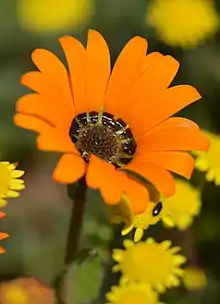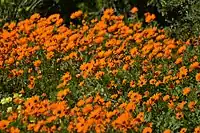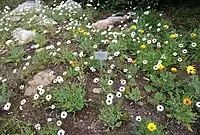| Arctotis hirsuta | |
|---|---|
 | |
| Scientific classification | |
| Kingdom: | Plantae |
| Clade: | Tracheophytes |
| Clade: | Angiosperms |
| Clade: | Eudicots |
| Clade: | Asterids |
| Order: | Asterales |
| Family: | Asteraceae |
| Genus: | Arctotis |
| Species: | A. hirsuta |
| Binomial name | |
| Arctotis hirsuta Beauverd[2] | |
| Synonyms[2] | |
| |
Arctotis hirsuta (Namaqua marigold, gousblom) is a species of flowering plant that is endemic to South Africa. It occurs in the provinces of the Northern Cape and Western Cape. Most typically found on sandy slopes and flats along the coast in the region between Elandsbaai to the Agulhas Plain. During the spring flower season it can flower in large numbers.[3]
It is an annual plant that can reach up to 450 mm in height. It is somewhat fleshy and has a branched stem. The leaves are slightly hairy, which explains the name hirsuta. They grow to 200 mm long. The flowers are orange, yellow or cream-colored and the flower heads are about 40 mm in diameter.[3]
Gallery
 Flowering in a dense field during the spring flowing season in West Coast National Park, Western Cape
Flowering in a dense field during the spring flowing season in West Coast National Park, Western Cape Flowering in the Northern Cape
Flowering in the Northern Cape
References
- ↑ "Threatened Species Programme: SANBI Red List of South African Plants". redlist.sanbi.org. Retrieved 2021-08-26.
- 1 2 "Arctotis hirsuta Beauverd". Plants of the World Online. Royal Botanic Gardens, Kew. Retrieved 2021-08-26.
- 1 2 "Arctotis hirsuta: PlantZAfrica". pza.sanbi.org. Retrieved 2021-08-26.
This article is issued from Wikipedia. The text is licensed under Creative Commons - Attribution - Sharealike. Additional terms may apply for the media files.
